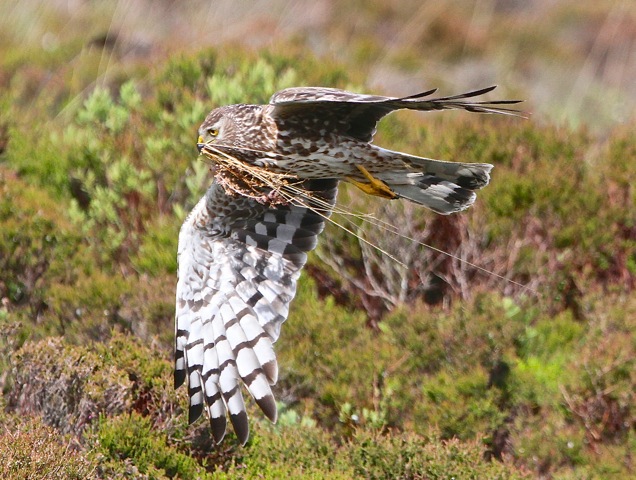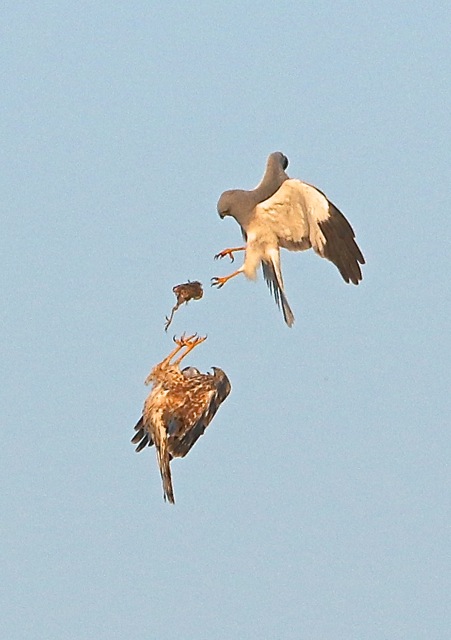
2016 saw a UK-wide Hen Harrier survey and the results are now out.
The 2016 estimate of the Hen Harrier population for the UK is 545 pairs which is quite a lot less than the 2010 survey’s estimate (633 pairs) and an awful lot less than that for 2004 (749 pairs). However, it is worth pointing out, that it is very similar to the totals for 1988/89 (534 pairs) and 1989 (521 pairs).
Hen Harriers are tricky to survey and their numbers go up and down between years depending on vole numbers so, as I point out in Inglorious (Chapter 1 but particularly pp27-28), it’s probably unwise to read too much into the differences between survey years, but there is no sign of Hen Harriers doing well over the last couple of decades. Incidentally, this year is, both by observation and report, a phenomenal vole year and Hen Harriers should be doing very well. I think we’ll find that is the case in Wales this year but I don’t think English Hen Harriers are being allowed to cash in on a vole bonanza, but we’ll see.
The most recent survey results for each UK country are as follows and I also give the potential number of pairs for each UK country from the Conservation Framework as an indication of how far short the actual numbers fall from what we should see:
Hen Harrier Surveys
| Potential pairs | 1988/89 | 1998 | 2004 | 2010 | 2016 | 2023 | |
|---|---|---|---|---|---|---|---|
| Scotland | c1700 | 479 | 436 | 633 | 505 | 460 | 529 |
| England | c330 | 18 | 19 | 10 | 12 | 4 | 50 |
| Wales | c250 | 27 | 28 | 43 | 57 | 35 | 40 |
| Northern Ireland | c150 | 10 | 38 | 63 | 59 | 46 | 34 |
| UK total | c2500 | 534 | 521 | 749 | 633 | 545 | 653 |
My assessment:
- We are missing about 2000 Hen Harrier pairs from the UK.
- Most of the missing Hen Harriers are missing from Scotland.
- The country with the greatest proportionate shortfall from its potential is England where the species has a tenuous hold as a breeding bird.
- Wales and Northern Ireland, have less suitable habitat for Hen Harriers but have shown signs of real recovery in numbers until the results from 2016 – neither country has much driven grouse shooting.
What others say – coming later today
The UK wide survey was carried out from the beginning of April to the end of July last year and as a partnership between RSPB, Scottish Natural Heritage (SNH), Natural Resource Wales (NRW), Natural England (NE), the Northern Ireland Environment Agency, the Scottish Raptor Study Group, the Northern Ireland Raptor Study Group, Northern England Raptor Forum and Manx BirdLife. It was co-funded by SNH, NRW and RSPB with the fieldwork being carried out by expert licensed volunteers and professional surveyors.
Hen Harrier Day rallies will be held in England, Scotland and Northern Ireland on 5 and 6 August this year – for initial details see here.

And the story made it onto the front page of the bbc news website I’m glad to see
One wonders what positive spin the likes of Amanda Anderson (MA), Andrew Gilruth (GWCT) and Tim Baynes (SLE) will put on this. It is nationally a 14% decline since the last survey and a 27% decline since 2004. Worst still it is just 22% of the potential with the English population at 1.3% of what it should be and we know none of that 1.3% were on driven grouse moors, which in England comprises the vast majority of suitable habitat, frankly that is scandalous.
It would be interesting to know what proportion of the Scottish population is on grouse moors, I suspect that too is very low.
Paul – indeed. And what will Michael Gove and Defra have to say?
There won’t be many HH on Scottish grouse moors (except Langholm of course)
Sadly, the Beeb article gave the impression that Hen Harriers just eat grouse, rather than a wider range of prey. Mind you, if grouse is all there is…
BBC presenters were far more animated this morning in telling the story of a young girl attracting cattle with her ukulele at which pointed I switched off.
Was she playing a properly patriotic tune to them? 🙁
The Hen Harrier was featured on every news bulletin on Radio 2 today too.
Quick quest does the survey take into account birds on the Isle of Man?
Douglas – thanks.
It does, but none of those figures are in what I have blogged about so far. I thought I’d ‘do’ the IoM some time tomorrow.
To me the figure of 633 pairs in the 2004 survey stands out like a sore thumb. After the publication of the Langholm report in the late 90’s numbers of breeding pairs dropped by 40% on managed grouse moors between successive surveys 1998 and 2004. With persecution, etc how could you get such a massive increase in breeding pairs away from managed grouse moors in such a short period of time? I personally wonder if this 2004 survey figure is correct because the data presented just doesn’t add up? I look forward to your comments Mark.
Mike – it is a notably high figure, but then others are notably low ones. I’m not sure there is anything to explain in terms of the figures not adding up.
If you look at the paper (link in this post) then Table 3 shows the geographic breakdown of those figures and there is a general increase in all Scottish non-driven-grouse-moor areas (and many of the between-survey changes are statistically significant), and Table 4 shows the breakdown by ‘habitat’ and that shows that increases in Scotland (away from Orkney) came from young plantations, mature plantations (which is interesting) and from a spread into grasslands, as well as on non grouse moors. Looks like HH did well in all areas and all habitats except on grouse moors.
Was 2004 a big vole year?.
Saw my first male Hen Harrier in North wales over the weekend, stunning bird and thankfully nowhere near any grouse moors.